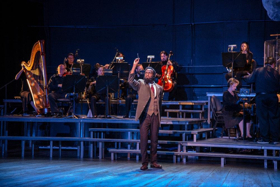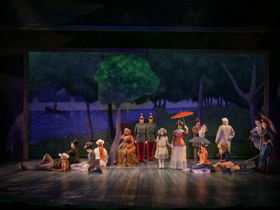Review: SUNDAY IN THE PARK WITH GEORGE Paints a Fantastic Piece of Theatre in Austin TX

Utilizing his own genius and artistic experiences, Stephen Sondheim paints the picture of an artist's life work through pointillist painter, George Seurat. In SUNDAY IN THE PARK WITH GEORGE, George's characterizations are fictionalized by Sondheim, telling the story of the artist chasing his masterpiece. However this famous artist's painting that this show is based on is very real: A Sunday Afternoon on the Island of La Grande Jatte. Creatively springing to life with it's variety of personalities throughout the park, SUNDAY IN THE PARK WITH GEORGE creates disposition and purpose for the subjects the artist is sketching. The pointillist's sweating muse is a young parisian woman named Dot, who is clearly a little grumpy from waking up so early to stand in the sun to be painted. From the top of the show, this introduces theme of sacrifice, both by the artist and those close to their work. As the Sunday morning progresses, more Parisian characters roll onto the stage displaying the Island of La Grande Jatte in 1884 as conceivably the trendiest brunching spot in modern day. As the different storylines begin to mix, much like the paint in George's brush strokes, Dot begins to feel alone posing idly. As a bystander in her own story as rather than the focus of a romance with her lover George, Dot arrives at a crossroads in her life. George's obsessing over his use of the colors red and blue in his famous painting reflect the hot and cold nature of his current love affair. Travelling a century into the future and revealing the heartache of networking within the arts community, the story quantifies the aftermath of a masterpiece. SUNDAY IN THE PARK WITH GEORGE examines the impact of an artist both during creation and in the distant future.
 Displaying the passion of George is Cecil Washington JR. The focus and obsession he brought to his performance welcomed the audience into the sacrifice and motivation of what would be characterized as a true artist. No doubt Sondheim was using self-reflection upon writing the character of George and I imagine Washington channeled his own experiences into the driving dialogue. Switching from the unrelenting task of bringing design, composition, tension, balance, light and harmony to his portrayal of this great painter, the audience enters George's mind through two performance highlights. Washington scurries on all fours in "The Day Off", channeling two lovable dogs depicted in his famous painting lounging in the park. Citing nuances and creating personalities for all painted subjects objectively, the song shades the sketching of the dogs into full personification. Brushing past the dogs, George arrives at a hat and the task of finishing it. During Washington's performance of "Finishing The Hat", we see his two loves collide. The love of his work and the pain associated with his damaged relationship with Dot. The peek inside George's creative process and feelings about Dot add needed context to point George and the audience into his picturesque direction.
Displaying the passion of George is Cecil Washington JR. The focus and obsession he brought to his performance welcomed the audience into the sacrifice and motivation of what would be characterized as a true artist. No doubt Sondheim was using self-reflection upon writing the character of George and I imagine Washington channeled his own experiences into the driving dialogue. Switching from the unrelenting task of bringing design, composition, tension, balance, light and harmony to his portrayal of this great painter, the audience enters George's mind through two performance highlights. Washington scurries on all fours in "The Day Off", channeling two lovable dogs depicted in his famous painting lounging in the park. Citing nuances and creating personalities for all painted subjects objectively, the song shades the sketching of the dogs into full personification. Brushing past the dogs, George arrives at a hat and the task of finishing it. During Washington's performance of "Finishing The Hat", we see his two loves collide. The love of his work and the pain associated with his damaged relationship with Dot. The peek inside George's creative process and feelings about Dot add needed context to point George and the audience into his picturesque direction.
Of course with George's love of the hat and his sketches, Dot is caught in the middle of his notebook. Dot, played by Jill Blackwood, was sung and performed beautifully with funny quips to boot. Yearning for her partner's passion, but desperately wanting to be happy, Dot is faced with the choice of moving on or playing second fiddle to George's bleeding colors. Blackwood humanized this conundrum for Dot with her motivations onstage. Although she was facing consequences for her choices, the audience roots for her to win. Blackwood transforms in Act II to play Marie, a presumed relative of the great painter. The switch was brilliant and didn't skip a beat. This no doubt displayed Blackwood's seasoned talent onstage and her ability to root her characters in the story.
Alongside our protagonists, the other park goers bring much life and laughter to the stage. Given the seriousness of the main love affair, the ensemble contribution within this show is hilarious. Equal accolades are deserved by the ensemble's performance, but also through the overall stellar direction given by Dave Steakley. The gags and jokes executed between characters and sets, or lack thereof are a product of creatively intuitive direction. The barrels of laughs came from Steakley reading between the lines and the actors' funny timing within the delivery. Amber Quick led a very comical performance between three different characters within the  show. Each differing in characteristics and ticks - Quick's timing along with her ensemble cast were hilarious and left the audience wanting more.
show. Each differing in characteristics and ticks - Quick's timing along with her ensemble cast were hilarious and left the audience wanting more.
With all the makeup and foundation a great show requires, Zach Theatre's production of SUNDAY IN THE PARK WITH GEORGE brings order to the whole. Differing from other productions focusing strictly on the life within the painting, Director Dave Steakley invites the orchestra on stage to be a part of the magic. George's brush strokes activate instruments, lights and sounds bringing the elements of live performance a makeover. Much like George chasing his masterpiece in Act I and selling it in Act II, Zach's production will sell itself. Through the focused direction and superb performance, the company and Zach Theatre production team hit the ball out of the park - mind you not only on Sundays, but 6 shows a week.
SUNDAY IN THE PARK WITH GEORGE
BY: Stephen Sondheim
Directed by: Dave Steakley
Wednesdays-Sundays,
May 30 - June 24, 2018
Zach Theatre
1510 Toomey Road
Austin, TX, 78704
http://zachtheatre.org/shows/main-stage/sunday-park-george/
Photo Credit: Kirk Tuck
Reader Reviews

Videos

